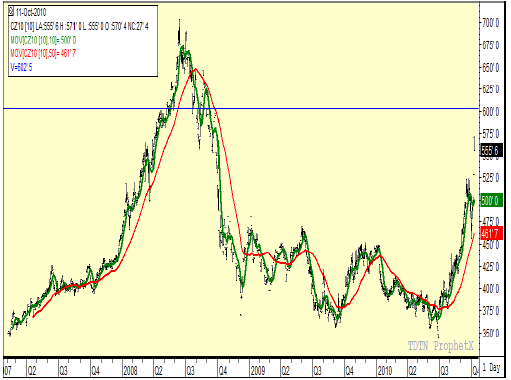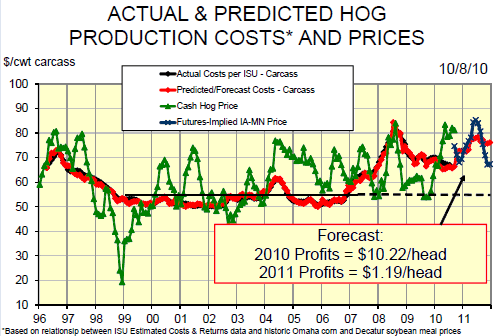



CME: Impact of Corn Estimates on Livestock, Poultry
US - The impact of Friday’s USDA corn crop estimate continued today with CME corn futures through July 2011 gaining 27.5 to 28 cents/bushel and soybean futures through August 2011 gaining 14.5 to 20.75 cents/bushel, write Steve Meyer and Len Steiner.Today’s closes were contract life highs for March, May and September corn but were not so for December ‘10, July or December ‘11. The December 2010 chart appears below. Today’s prices are no doubt into new territory but there does appear to be a few resistance points in the chart based on some localized highs back in 2008 The first of those is at $6.02-1/2. Every new-crop soybean meal contract went above $320/ton in today’s trading.

As an example of the impact of these grain price increases, consider the hog cost and price chart below. Today’s price increases pushed our estimate of Iowa breakeven costs of production for hogs to $76.47/cwt. carcass. That compares to $70.13/cwt. carcass just ONE WEEK AGO and is an increase in total costs of nearly $13/head. Projected profits for 2011 are still positive — barely — at $1.19/head. That figure is over $5/head lower than just one week ago. None of that is good but hog producers are saying “Thank goodness for a big LH rally on Friday!”

Higher corn will cause major pain for all livestock and poultry sectors but the popular question, based on the press calls we had on Monday is “Which species is hurt the most?” The answer is not 100 per cent clear but here are some factors that will have major bearing:
- Hogs are probably the most dependent on corn since energy ingredients (of which corn in the major one in the US) comprise over 70 per cent of the average hog diet. Wheat mids, milo, barley, DDGS, waste pet food, bakery by-products and others are energy substitutes but their value — and price — is highly correlated with the price of corn. Higher soybean meal impacts hogs as well since, being simple-stomached animals, they must have sufficient amounts of all essential amino acids in their diets. Weighing against this negative impact is the fact that hog prices and futures are high by historical standards and that the sector has yet to expand — and very likely will not given these cost developments.
- Chickens and turkey are more dependent on soybean meal since it comprises a higher proportion of their diets. SBM has risen by a smaller percentage than corn so far and that factor suggests that poultry costs have not gone up by as large a percentage as hog costs. But — the chicken business is well in to an expansion phase after the contraction of 2008 and 2009. They already have a larger breeding flock in place and chicken production for the week that ended October 2 was 6.7 per cent larger than one year ago while egg sets were up 7.8 per cent and chick placements were up 5.6 per cent. Chicken producers can turn things quickly but have historically duked it out over market share. Will that happen again?
- Cattle costs will change the least due to the ability of cattle to use a wide variety of feed ingredients due to magic of rumen fermentation. In addition, there is slack capacity in US feedlots meaning that feeders can cheapen diets and sacrifice average daily gain to reduce feed costs. Be aware that this may impact the relationship of steer/heifer slaughter to feedlot placements since it will very likely take longer for cattle to reach market weight. More important: Higher costs will be taken out of calf prices, thus driving cow-calf returns lower and causing even more beef cow liquidation, especially with higher costs just as winter approaches.








